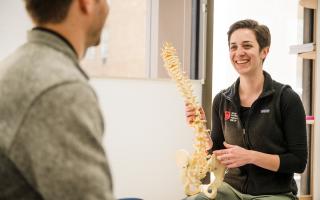
Ergonomics
“Ergonomics is the scientific discipline concerned with the understanding of interactions among humans and other elements of a system, and the profession that applies theory, principles, data and methods to design in order to optimise human well-being and overall system performance.” International Ergonomics Association
The terms ‘ergonomics’ and ‘human factors’ can be used interchangeably, although ‘ergonomics’ is often used in relation to the physical aspects of the environment, such as workstations and control panels, while ‘human factors’ is often used in relation to wider system in which people work.
At Rose Phyiscal Therapy Group here in Washington, DC, we have developed our ergonomics approach based on the Occupational Health and Safety Assocation (OSHA) requirements and our knowledge of human physiology and physical therapy. Ergonomics is the science of fitting the job to the person, rather than requiring the person to conform to the physical parameters of the job. An Ergonomic Evaluation is a formal, structured process that assesses many physical and cognitive parameters of the worker, the workspace, and the job characteristics to determine if the job fits the worker and to identify ALL risk factors. What is important about this? Adapting the job to the worker helps lower risk factors that can lead to injury, improves productivity, and increases employee morale. Ergonomics focuses on the work environment, ensuring the demands of the job match the employee’s physical capabilities. Workplace conditions may be restructured or modified to reduce stressors that cause musculoskeletal disorders.
How does Rose evaulate ergonomics?
The assessment is performed by a licensed physical therapist or physical therapist who performs the following:
- Suggests options for solving ergonomic safety issues
- Assists in establishing or improving work- site injury and illness prevention programs
- Helps employers identify hazards in the workplace
- Works with employers to identify and develop health and training for employees
- Provides employers with written reports to summarize findings
Environmental factors can often be accommodated to a client’s temporary or long-term limitations. The ergonomic assessment may involve both remediation or prevention of further injury. On-the-job injuries are often costly to employees, employers, and insurers. Activities to promote prevention may represent a sound investment.
Common Areas for evaluation include
- Work site analysis
- Desk height
- Chair design
- Location of computer station
- Effectiveness of work area
- Incorporation of pacing techniques to reduce incidence of work-related injuries
- Prescription for adapted aids
Common Musculokeletal Disorders caused by poor ergonomic environment
- Carpel Tunnel Syndrome
- Trigger finger
- Tendonitis
- Back/neck pain
Upon completion of an ergonomic assessment, a report is generated that includes
- Positive aspects of the job
- Risk factors of the job
- Risk modification or control
- Management solutions
- Exercise programs
- Training and education programs to promote safety and increase productivity
What your Rose therapist is looking for
Having an ergonomic workstation means that your desk and the things on it are arranged in such a way, that they prevent injury and are well within reach and use. An ergonomic workstation also promotes good posture. Posture is the position in which you hold your body upright against gravity while standing, sitting or lying down. An ergonomically designed workstation promotes good posture and helps to:
- Keep bones and joints in the correct alignment so that muscles are being used properly.
- Help decrease the abnormal wearing of joint surfaces that could result in arthritis.
- Decrease the stress on the ligaments holding the joints of the spine together.
- Prevent the spine from becoming fixed in abnormal positions.
- Counter fatigue because muscles are being used more efficiently, allowing the body to use less energy.
- Prevent strain or overuse problems.
- Avert backache and muscular pain.
Proper ergonomics plays an instrumental role in how effectively you accomplish work and will help prevent suffering from work-related injuries due to strain and overuse. In the diagram below you will find both sitting and standing workstation recommendations to achieve a proper ergonomic workstation.
Rose Physical Therapy is here in Washington, DC to help!
If you are interested in working with Rose Physical Therapy Group in Washington, DC to adjust your workstation ergonomics, please reach out by calling or through our website. Physical Therapists at our downtown Washington DC location between Dupont Circle and Farragut Square, or our office in the Capitol Riverfront near Navy Yard and a couple blocks from Capitol Hill in Southeast Washington, DC, can help schedule your ergonomics appointments and also discuss working with your entire office to provide an end-to-end solution. Give us a call or request an appointment through our website.




